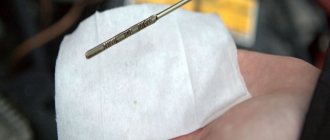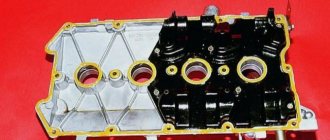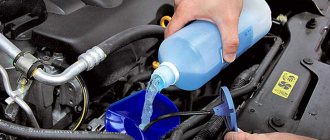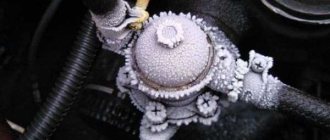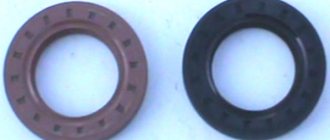Because You are not logged in. To come in.
Because The topic is archived.
I washed it first with gasoline, and then with just water, once with technical water.
PS: used plastic vat containers from some kind of chemicals, where are they sold and at what price? Maybe someone knows. ¶
Today in Nizhny Novgorod a style festival took place - we are not talking about a banal pretentious event, but about a race with the good ones.
A professor at one of Russia's leading universities of architecture and construction may lose his academic degree due to accusations of plagiarism. We are talking about.
Perhaps the phrase “better late than never” describes this event perfectly. The cascade has finally been restored in Avtozavodsky Park.
Repair is a real challenge for a family. A hundred questions arise that have no answers, and a lot of problems that are urgently needed.
Housewives often pour vegetable oil into a glass bottle - this way the product better retains its taste and beneficial characteristics. However, few people know how to quickly and effectively wash a bottle of sunflower oil. In fact, this can be done easily, you just need to know the little tricks and be able to apply them in practice.
Removal methods
Vegetable oil is a lipid mixture that does not interact with water. To remove it, you need to use a substance that can penetrate inside the fat molecule and remove it from the surface.
You can use detergents that contain surfactants. They will help you get rid of greasy stains on the surface without difficulty. If you run out of dishwashing liquid, it doesn’t matter - it can be replaced with products that are available in every kitchen.
Such products include:
Each product is effective in its own way and will help restore containers to cleanliness without much effort.
Cleaning with soda
Any remedy for many housewives is baking soda. With its help you can remove most kitchen stains, including traces of sunflower oil. To clean the container you need to prepare the following mixture:
- 2 tbsp. soda;
- 1 liter of hot water.
Pour the resulting solution directly into the bottleneck and leave until it cools completely. The container must stand for at least 2 hours, then the water is drained and the container is washed several times. There should be no traces of grease left, otherwise the cleaning must be repeated.
How to clean an oil bottle with vinegar
Another excellent lipid solvent is vinegar. You can use the product with any concentration - essence or 6.9% solutions. In any case, the result will be noticeable. The solution, which is poured into the container, is prepared as follows:
- 3 tbsp. 9% vinegar (4 tbsp 6% vinegar or 1 tsp essence);
- liter of water.
Shake the mixture and pour it into the bottle. Close the top with a stopper and shake, then carefully remove the lid to let the gas escape and repeat the shaking. Let the mixture stand for 2-3 hours. Then pour out the vinegar water and wash the container. Oil stains will disappear, and the glass will shine beautifully.
With mustard
You can try to clean the container from fat using mustard powder. The powder must first be diluted in hot water at the rate of 2 tbsp. per liter of water. The resulting mixture is stirred so that there are no lumps and poured into the neck of the container to the very top. Leave the product to act for 2 hours, then drain it and wash the container.
During this time, the mustard corroded the adhering oil that was on the walls. For greater effect, it is recommended to repeat the treatment 2-3 times in a row.
Flour
As an alternative to other means, flour is sometimes used to remove oil. Flour perfectly absorbs any liquid, including oil stains.
For a liter bottle take 2 tbsp. flour and pour it straight inside. When the product is in the container, it is turned over so that all the walls are covered with white powder. After this, pour 1 tbsp into a container. any rice and shake the container with cereal for 10 minutes.
Add water and a couple of drops of any dishwashing detergent, and then drain the contents into the sink. The flour absorbed the fat, and the rice helped remove it from the surface. As a result, the bottle is clean and ready for further use.
Boiling
If several bottles have accumulated and there is no time to clean them, you can use boiling. Pour water into a large saucepan or large bucket. The entire container is filled halfway with water and 2-3 drops of any detergent are added. The containers are transferred to a saucepan and heated over medium heat, boiling for 20-30 minutes. Then, when the contents of the pan have cooled a little, the container is taken out and rinsed several times.
How to remove from different surfaces?
Depending on the specific item that needs treatment, the means for neutralizing extraneous odors will differ. Those compositions that can be used to wash the canister are not suitable for caring for the skin of your hands.
From a canister
A canister saturated with the aroma of diesel fuel is not suitable for storing other liquids. To rid it of odor, it is necessary to wash it using various means. The most accessible of them is citric acid.
Mode of application:
- dissolve 40 g of citric acid in 5 liters of water;
- pour the product into the canister;
- After 12 hours, pour out the solution and rinse the container with clean water at least 3 times.
This product is suitable for processing both plastic and iron canisters. However, even after neutralizing the fuel plume, the container should not be used to store drinking water.
From a barrel
It is more difficult to rinse a barrel, since it is of impressive size. Therefore, you need to choose the method that will work the first time. The most effective method is to burn the barrel.
Procedure:
- Find a place away from buildings, dry grass and other objects that could catch fire.
- Using a gasoline lamp, the barrel body must be burned from the outside.
- Then fill the container with ordinary water right up to the lid and boil it over an open fire for an hour.
- After completing the procedure, the barrel is treated with anti-rust.
To remove carbon deposits, wipe the walls of the container with an old rag.
This video will show you how to clean a barrel of gasoline and diesel fuel:
From clothes
Washing with pre-soaking will help remove the smell of diesel fuel from clothes. For this purpose, the following means are used:
- lemon acid;
- vinegar and caustic soda;
- laundry soap;
- dishwashing liquid;
- ammonia solution.
You need to soak clothes for at least an hour, after which they are washed as usual. A prerequisite is to dry things in the fresh air. Read more here.
The video will tell you how to wash clothes from gasoline:
From inside the car
A car interior that smells of diesel fuel is not only unpleasant, but also dangerous. Inhaling fuel vapors leads to headaches and reduces concentration.
You can deal with the problem using the following means:
- Perform a wet cleaning of the interior using shampoo.
- Sprinkle the stains with ground coffee, and also place several jars in different places of the car.
- Spray all surfaces with a weak vinegar solution, then ventilate the interior for 24 hours.
If the weather permits, you should drive with the windows open for several days after treatment.
In room
Wet cleaning is the most effective way to combat odors in a room. Main points to be completed:
- wash all hard surfaces with soapy water;
- use a steam generator to walk over the surface of furniture and carpets;
- wash curtains;
- wash bedding and clothes with conditioner.
It is recommended to keep windows and doors open for several hours, and clothes should be dried in the fresh air.
From hand
To stop your hands smelling like gasoline or diesel fuel, you need to wash them well with soap . The water must be hot.
If this method does not help, then use lemon juice. It is squeezed onto a sponge and passed over the skin. Then rinse your hands again under running water.
It is not recommended to use aggressive products, such as alcohol, so as not to dry out the skin.
How to clean oil from a bottle if its neck is narrow
To remove sunflower oil as effectively as possible, you need to use a special device - a bottle brush. It is sold in hardware and household goods stores and costs about 30-50 rubles. At its end there is a hard pile that allows you to wash off any dirt from the surface. Cleaners come in different diameters - it depends on the size of the neck of the container.
You can make a brush at home yourself. You will need a long knitting needle, on the end of which a coarse fabric or foam rubber is wound. The fabric must be firmly fixed so that it does not slip during the process. Now you can use the device to clean any container.
Removing unpleasant odor from a bottle
Even a clean bottle may smell damp and musty if, for example, it was left wet with the cap closed. This smell can be removed in several ways:
- With the help of coffee. An excellent absorber absorbs even strong odors instantly; after just a couple of minutes the container will smell pleasant. Add 2 tbsp. freshly ground coffee powder into the neck, close the lid and leave for 2 days. Then, after the time has passed, the coffee is poured out, and the bottle is rinsed and dried with the lid open.
- Lemon juice. Dilute the juice of one lemon in a glass of water and pour the resulting liquid into a container. Shake well with the lid closed and then leave for the whole day so that the lemon juice absorbs the unpleasant odor. Then drain the liquid and allow the bottle to dry thoroughly.
- Orange zest. Remove the zest from one orange and place it in a bottle for 2-3 hours. Then they remove it and add a new portion. After 2-3 such manipulations, nothing will remain of the unpleasant odor.
Cleaning a bottle of oil traces is as easy as shelling pears and does not take much effort and time. Do not delay cleaning, as fresh marks are removed much easier than old ones. With regular washing, your oil storage bottles will last a long time and look like new.
Sometimes it’s tempting to reuse a cute bottle of olive or sunflower oil. It can be difficult to clean forgotten containers that stink of musty odor and are covered with an ancient layer of grease. Oil is oil. However, there are still a couple of proven folk remedies that can cope with the pungent odor and ingrained fat.
Simple ways to clean a bottle of sunflower or olive oil:
Method 1: Heat a solution with a high concentration of soda. The temperature should be high, but not so high that the bottle bursts. Pour the solution into a bottle and let it sit for 12 hours. After pouring out the contents, you will be convinced that there was no smell or fat.
A little secret: if you put a metal chain into a bottle with a solution and then shake it, it will act as a brush, “beating” the remaining oil from the walls. Rice will act in a similar way (literally a couple of tablespoons).
Method 2: In the same way as salt, use vinegar or lemon solution, adding as much vinegar or citric acid as possible. In this case, it is advisable to leave the bottle for a day.
Method 3: If you need to remove the smell in a shorter time, you can use mustard powder. For one bottle, one tablespoon of this powder and 1/4 part of warm water is enough. Shake the bottle thoroughly for five to ten minutes. After this, pour out the water and make sure that the smell is completely removed. If not, you should repeat the operation again.
Method 4: Add a few teaspoons of coffee grounds and warm water to the bottle. Shake the container well, then pour out the water and rinse. Pour in new warm water and add a tablespoon of soda. Leave for a couple of hours.
Method 5: Use water from under jacket potatoes. After boiling the potatoes, warm water should be poured into a bottle and left for several hours.
Method 6: Sometimes bottles are difficult to wash even with a long-handled brush. In these cases, you need to pour water in which the washing powder is dissolved into a bottle and let it stand for as long as possible.
Method 7: Contaminated bottles are quickly cleaned using a solution of vinegar and salt.
Method 8: There is an even simpler way to quickly wash a bottle - ordinary sand. To do this, pour a tablespoon of sand into a bottle, pour in water and shake well. The bottle will become clean.
How to properly clean mechanically
Probably, almost every person in his life has at least once washed a container that has a green residue. But how should cleaning be carried out correctly without harming your own health?
The most common reason that greens appear in this kind of container is the so-called chlorella algae, which, in principle, is not capable of causing much harm to the body. But everyone wants to store water in a normal container. For this reason, most housewives are wondering how to clean a container of greens without resorting to harmful agents.
The following simple methods will help you cope with the presence of algae in plastic bottles:
- Baking soda, available in every home, perfectly cleans any container. You need to pour soda into the bottle and leave it for literally a few hours. In this case, the calculation should be as follows - for every twenty liters you will need about half a pack. You will need to add some water to the container. Then you will need a clean cloth, after which you need to shake the bottle for ten minutes. After performing this procedure, it is necessary to rinse the remaining product with running water.
- To clean a plastic bottle, you can use a regular chain, which should be thrown into the container and filled with it. Then shake the container and rinse.
- We wash off deposits on the container with ordinary millet, the amount being calculated as half a kilogram per twenty-five liters. It should be poured into a container and filled with water, after which it should be shaken for ten minutes. You can also use liquid soap to clean bottles.
- The folk method also includes the use of ordinary newspapers, which should first be torn and crumpled. After this is done, the lumps must be placed in the neck and filled with clean water. Then you should shake the bottle and turn it for five minutes.
We suggest you read: How to clean silver with ammonia and peroxide
The methods listed above, as a rule, allow you to immediately clean plastic bottles, but if the housewife is alarmed by these manipulations, then you can use herbs.
If you have a clean container in your hands, the next problem arises - how to dry it. In practice, it turns out that using a hairdryer is unsuccessful.
Glass bottle
The method will require any type of paper, but preferably one that absorbs moisture well. Even kitchen towels will do. A piece of paper is rolled into a tube and placed inside. It is advisable that the end sticks out of the container, as it is needed in order to remove the paper.
Plastic
The container is turned upside down and placed on the surface. It is advisable to place something under the neck. Air should come inside, which will speed up drying.
The cleaning principle is the same as for a plastic or glass vessel. Since the thermos is used for making tea or coffee, the walls become covered with a dark coating. Citric acid or fresh lemon will help with this. The thermos is filled with water, to which lemon juice, zest or pulp is added. The container is left overnight.
An original way to wash a bottle of vegetable oil.
An incredibly interesting and original video recipe on how to clean a bottle of vegetable oil was found on the Internet.
1. Let the oil in the bottle drain dry: tip it upside down into a bowl and leave for a day.
2. Next, put 4 tablespoons of flour inside (per liter bottle). Now you should twist the bottle, distributing the flour along the walls of the vessel, leave it for 10 minutes, and then shake it out.
3. Now take regular rice and put 3 tbsp inside the bottle. spoons and vigorously twist the bottle. Rice perfectly removes flour from hard-to-reach corners.
4. Add another 1 tbsp. spoon of flour and twist again.
The principle is simple: flour absorbs the remaining oil and “removes” it from the surface of the bottle. And the rice, in turn, knocks the flour and oil off the walls of the bottle.
5. Without removing the contents, fill everything with water and shake and twist again along with the rice and flour.
6. Pour out all the contents. Add 1 tbsp. spoon of any detergent, add a small amount of water. Place 1 tbsp inside. spoon of rice, shake vigorously and let stand.
7. It remains to rinse with water 4-5 times. The bottle even creaks!
8. If you plan to use the bottle for food purposes, it is recommended to fill it with water, cover it and leave for a day, then rinse thoroughly again. This will completely rinse off any remaining detergent.
We hope that with the help of these tips, the painful dilemma of how to wash a bottle of vegetable oil will be easily resolved!
Removing green stuff from a canister using household chemicals
You can also clean green water from a water canister using chemicals. But keep in mind that after using chemical cleaners, it is very important to thoroughly rinse the container. Particles of substances remaining on the walls can be harmful to health.
How and how to clean the canister:
- Cleaning powder with water. One way to use a greens canister is to fill it with non-powder, add water and shake well. If you repeat this process several times, the result will be excellent.
- Savo or sodium acid. This is a harsh chemical option. Pour cleaning agent or sodium acid into a container and mix with water. Shake, pour, rinse with clean water.
- Rice, boiling water and dish gel. An interesting way to wash a canister is to pour rice into it, pour boiling water over it, and add dish gel. Shake well, leave for a while, shake again. The walls of the product will become clean, the plaque will disappear. Do not use boiling water on plastic bottles!
We suggest you familiarize yourself with How to clean the seams between tiles on the floor in the kitchen from dirt: cleaning products for floor tile seams
How to clean dishes from burnt vegetable oil
Quite often, housewives who care about the health of their family refuse universal detergents and prefer traditional methods of cleaning kitchen utensils. How to clean a pot or frying pan from burnt oil? An effective and proven method over the years is as follows:
- prepare a mixture of baking soda with the addition of hydrogen peroxide;
- apply the mixture to areas contaminated with grease;
- let the dishes with the applied mixture stand for 40 minutes;
- remove grease using kitchen sponges;
- Rinse the dishes under running water.
The same mixture can be used to clean tiles and floors from vegetable oil. For kitchen furniture, a different mixture is used, which simultaneously removes stains and polishes the surface. To make your furniture look clean and well-groomed, rub it with a mixture made from soda and a few tablespoons of oil with the addition of natural oils. With such cleaning, the furniture regains its original appearance, is cleared of stains, and the air is filled with pleasant aromas.
Cleaning a canister from green deposits using folk methods
How to clean a plastic (or any other) canister from deposits, greens and mold on the inner walls? If the container is not cleaned for a long time or water remains in it for a long time, sediment may remain at the bottom, a green coating may appear on the walls, and mold may appear around the neck. To get rid of them, you need to thoroughly clean and disinfect the canister. The following instructions are suitable for cleaning both plastic canisters and containers made of other materials.
As for the barrels, cleaning is simple. Their openings are so large that you can use both hands when cleaning. The use of detergents, absorbents, cleaning powders with water or other suitable means is allowed (usually the cleaning capabilities are indicated on the label on the product itself or on the box). Of course, as with canisters, regular washing and cleaning is recommended to prevent dirt from becoming entrenched inside the barrel.
Important! If eliminating green deposits at home is not possible, buy a new canister.
Regular cleaning of the canister during regular use:
- After pouring out the remaining liquid, pour a little dishwashing gel into the container and fill it with moderately hot water.
- Wait until the product absorbs dirt and possible deposits, then shake thoroughly.
- Pour out the detergent water and rinse the canister several times with clean water to remove any remaining soap.
- Leave the container to dry completely, placing it upside down (ideally positioned so that air can flow through the neck).
How to remove vegetable oil stains from clothes and upholstered furniture
Unfortunately, sometimes careless handling of oil can lead to stains on clothing or upholstery. This problem can be easily fixed if you use old proven methods:
- sprinkle starch or salt onto the stain, cover with a clean cotton rag and iron;
- use a solution consisting of dishwashing liquid and ammonia. Moisten the stain well on both sides, then cover the stain with paper or rags and iron with a hot iron;
- Apply a solution of turpentine with laundry soap and ammonia. The product is applied generously to the contaminated area, left for a short time (10-15 minutes) and carefully removed with soft sponges, constantly wetting them in water.
Important! Before starting work, you need to take care of personal protective equipment - rubber gloves, personal respirators, etc.
If you listen to our recommendations and follow the advice, then you will not have any problems with how to quickly and efficiently remove oil from surfaces and remove stains.
The largest independent platform for discussing the production and processing of plastics and elastomers in various ways. Recommendations from leading experts.
- Unanswered topics
- Active topics
- Search
- our team
- PlastExpertForum about polymers Miscellaneous/OtherQuestions to experts from beginners/Questions from beginners
- Search
Video on the topic
Watch videos in which experienced specialists will tell you how to properly clean a plastic bottle from dirt:
Young mother, wife and part-time freelancer. Being a lawyer by training, I am accustomed to collecting and providing the most complete and reliable information. Constantly improves in the professional field and strives for personal growth and development.
Found a mistake? Select the text with the mouse and click:
The habit of using an automatic washing machine “sparingly” can lead to the appearance of an unpleasant odor in it. Washing at temperatures below 60℃ and short rinses allow fungi and bacteria from dirty clothes to remain on internal surfaces and actively multiply.
Stretch ceilings made of PVC film can withstand from 70 to 120 liters of water per 1 m2 of their area (depending on the size of the ceiling, the degree of its tension and the quality of the film). So you don’t have to worry about leaks from neighbors above.
There are special traps to combat moths. The sticky layer with which they are covered contains female pheromones that attract males. By sticking to the trap, they are eliminated from the reproduction process, which leads to a decrease in the moth population.
Threads made of gold and silver, which were used to embroider clothes in the old days, are called gimp. To obtain them, the metal wire was pulled for a long time with pliers to the required fineness. This is where the expression “to drag out the rigmarole” came from - “to do long, monotonous work” or “to delay the completion of a task.”
Fresh lemon is not only suitable for tea: clean dirt from the surface of an acrylic bath by rubbing with half a cut citrus, or quickly wash the microwave by placing a container of water and lemon slices in it for 8-10 minutes at maximum power. The softened dirt can simply be wiped off with a sponge.
The dishwasher cleans more than just plates and cups. You can load it with plastic toys, glass lamp shades and even dirty vegetables, such as potatoes, but only without using detergents.
Before removing various stains from clothing, you need to find out how safe the selected solvent is for the fabric itself. It is applied in a small amount to an inconspicuous area of the item from the inside out for 5-10 minutes. If the material retains its structure and color, you can move on to stains.
The easiest way to remove scale and carbon deposits from the soleplate of the iron is with table salt. Pour a thick layer of salt onto the paper, heat the iron to maximum and run the iron over the salt bed several times, applying light pressure.
If your favorite things show the first signs of gestation in the form of untidy pellets, you can get rid of them using a special machine - a shaver. It quickly and effectively shaves off clumps of fabric fibers and returns things to their proper appearance.
source
How to clean machine oil cans
How to clean machine oil cans
#1 Post by Natali » Jan 20, 2013, 3:02 pm
Re: How to clean machine oil cans
#2 Post by Damir » Jan 20, 2013, 05:34 pm
Re: How to clean machine oil cans
#3 Post by DODGE » 21 Jan 2013, 08:45
Re: How to clean machine oil cans
#4 Post by Natali » January 21, 2013, 09:46
Re: How to clean machine oil cans
#5 Post by DODGE » Jan 21, 2013, 11:24 am
Re: How to clean machine oil cans
#6 Post by Natali » Jan 21, 2013, 11:49 am
Re: How to clean machine oil cans
#7 Post by DODGE » Jan 21, 2013, 01:03 pm
Re: How to clean machine oil cans
#8 Post by Natali » Jan 21, 2013, 01:24 pm
Re: How to clean machine oil cans
#9 Post by DODGE » Jan 21, 2013, 1:36 pm
Re: How to clean machine oil cans
#10 Post Like a chemist » Jan 21, 2013, 4:17 pm
Re: How to clean machine oil cans
#11 Post by Natali » Jan 21, 2013, 4:54 pm
Re: How to clean machine oil cans
#12 Post by Maks42 » Jan 21, 2013, 05:01 pm
Re: How to clean machine oil cans
#13 Post by Natali » Jan 21, 2013, 05:36 pm
Re: How to clean machine oil cans
#14 Post by Maks42 » Jan 21, 2013, 6:35 pm
Re: How to clean machine oil cans
#15 Post by Natali » Jan 21, 2013, 6:55 pm
Re: How to clean machine oil cans
#16 Post by Damir » 21 Jan 2013, 20:45
Re: How to clean machine oil cans
#17 Post by Natali » 22 Jan 2013, 15:22
Re: How to clean machine oil cans
#18 Post Like a chemist » Jan 22, 2013, 4:41 pm

